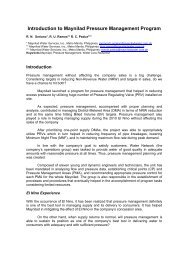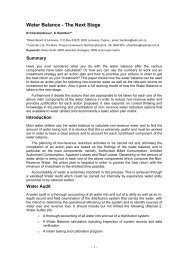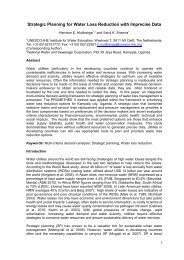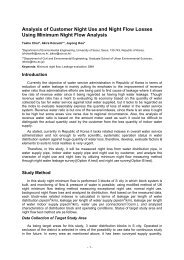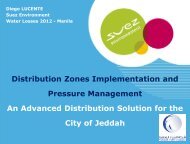its Role and Challenges in Moving Indian Cities ... - Iwa-waterloss.org
its Role and Challenges in Moving Indian Cities ... - Iwa-waterloss.org
its Role and Challenges in Moving Indian Cities ... - Iwa-waterloss.org
You also want an ePaper? Increase the reach of your titles
YUMPU automatically turns print PDFs into web optimized ePapers that Google loves.
IntroductionPopulation = 1,100 million. Predictedto overtake Ch<strong>in</strong>a by 2050. Already50+ cities over 1 million.Excess of water dem<strong>and</strong> over supplyis a major problem <strong>in</strong> India.Intermittent supply was generallydeemed to be the solution. This hasbeen practised nationally for ageneration or more!No <strong>Indian</strong> City has 24x7 water supply!2
Detrimental effects <strong>in</strong>clude: Excess valve operation Adverse health outcomes from<strong>in</strong>gress of polluted ground water Reduced customer confidence Ab<strong>and</strong>onment of metered suppliesreplaced with flat rate tariffs. Poor levels of service. Limited the Utilities’ ability to justify tariff<strong>in</strong>creases.3
The Government of India’s aspirations forimproved services.World Bank undertook prelim<strong>in</strong>aryassessments of performance <strong>in</strong> three typicalcities to guide the future preparation ofService Improvement Plans (SIPs) <strong>in</strong> projectcities with a view to support<strong>in</strong>g this via apossible Project.Government of India’s 11 th Five-Year Plan(2007-12) specifically refers to NRWreduction for the first time4
This paper provides1. Initial f<strong>in</strong>d<strong>in</strong>gs on the NRW situation <strong>in</strong>three typical cities <strong>in</strong> India2. Outl<strong>in</strong>es the NRW managementactivities required as an <strong>in</strong>tegralelement of the project “SIPs”.3. Describes results from recent projectswith NRW elements <strong>in</strong> 24x74. Outl<strong>in</strong>es future planned works <strong>and</strong>Conclusions for the way forward5
1. None of the 3 Utilities had aclear NRW Management Plan.2. No staff had NRW tra<strong>in</strong><strong>in</strong>g3. No access to the resources <strong>and</strong>equipment needed for <strong>in</strong>troduc<strong>in</strong>gNRW Management4. Other major constra<strong>in</strong>ts wereobserved.7
Results of the Assessment Water Balances madeus<strong>in</strong>g ULBs own figures Huge NRW > 65% Incredible ILIs >1,000!!!8
Problem with Intermittent SupplyDifficult for:ALCHydraulic modell<strong>in</strong>gNight flow measurementsMeter<strong>in</strong>g(=> <strong>in</strong>accurate water balances)So this presents a huge challenge!How can we move forward????10
The Scale of the Challenge tomove to 24x7 supplyIf we move to 24 hr supply from(say) 4 hour supply, leakagelevels will potentially <strong>in</strong>crease(x6)!But Wastage will certa<strong>in</strong>lydecrease if meters are <strong>in</strong>stalled11
So how can weprovide 24x7 supply<strong>and</strong> reduce NRW atthe same time?12
Typically, <strong>in</strong> Bhubaneswar averagemonthly billed quantities = 43m3(even at 4hrs supply per day!)This is more than sufficient for anaverage household size of 6persons.(6 x 130 l.c.d. x 30 days = 23.4m3)So enough water is usually available!13
The NRW Cycle towards 24x7Increase supply timeTherefore Carry out less ALC.Carry out essentialwastage Fix Increase leaks. supplystructural adjustmentsReplace still time SCs furtherof network(Start<strong>in</strong>g with smallDemo Zone /DMAs)BetterLosses <strong>in</strong>crease –But wastage Exp<strong>and</strong>(more uniformMore decreases ALC. Demo24 hour) pressure more! profileTherefore Gradual acceptancereduced lossesof meter<strong>in</strong>gMake Hydraulic(with so more meterModel<strong>and</strong> Wastage calibrate F<strong>in</strong>ally when & Reach Leakage ~ 50% 24x7 isuniform decrease all Supply covered SCs pressure) further Timewith acceptable NRW !!MoreFix MoreALC, Zones MoreLeaks.DMAsMore DMAs14
The Way Forward NRW reduction will be a coreactivity to achiev<strong>in</strong>g theobjectives of the proposedproject 2 Phases – dur<strong>in</strong>g SIP 1(pre-feasibility studyactivities) <strong>and</strong> SIP 2(feasibility study activities). 15
SIP Stage 1 - Objectives(Pre FS level assessment)Water Balance – assess NRWcomponentsPrepare Pilot DMA designsHydraulic modelULB’s <strong>in</strong>vestment commitmentsManagement Model decision16
SIP Stage 2Feasibility Study Level: to deepenunderst<strong>and</strong><strong>in</strong>g of challenges => preparefirst tranche of large scale <strong>in</strong>vestments. Prepare calibrated hydraulic model Set up the Pilot DMAs to accuratelyquantify Water Balance & confirm<strong>in</strong>tegrity via ZPTs Leak detection <strong>and</strong> repair, together withmeter <strong>in</strong>vestigation <strong>and</strong> trac<strong>in</strong>g illegalconnections should then proceed.17
SIP Stage 2 Clear <strong>in</strong>dications will beavailable regard<strong>in</strong>g the impactof a 24x7 supply <strong>and</strong> effects ofconstant pressure on thenotional leakage levels. Cont<strong>in</strong>ue to operate DMAs Detailed assessments of all PilotDMAs will be made with robustWater Balances be<strong>in</strong>g available.18
SIP Stage 2 (cont<strong>in</strong>ued)Clarify the causes of the physical <strong>and</strong>commercial lossesFigures become available for Nos. of piperepairs <strong>and</strong> replacements, service connectionreplacements <strong>and</strong> meter<strong>in</strong>g requirements etc. tobe <strong>in</strong>cluded <strong>in</strong> the ma<strong>in</strong> project implementation.In particular the necessity of reduc<strong>in</strong>gleakage levels without resort<strong>in</strong>g towholesale pipe replacements will becarefully <strong>in</strong>vestigated.Result of SIP2 => Develop strategy for NRWreduction e.g. Roll out program – where <strong>and</strong> when19to establish DMAs, approach to ALC, costs etc.
3 Recent ExperiencesNagpurMalkapurKarnataka20
Recent Experiences (1) Recent NRW reduction <strong>in</strong> KarnatakaState showed that when a 24x7 supplywas provided, together with meteredservice connections, overall consumptionlevels actually reduced. The effect of a 24x7 supply on potential<strong>in</strong>creased leakage but offset by reducedwastage therefore needs to be carefully<strong>in</strong>vestigated <strong>and</strong> quantified.21
Results from Demo Zones <strong>in</strong> KarnatakaStateParameterSituationbeforeSituation after<strong>in</strong>terventionHours of supply 2 hours <strong>in</strong> 3-7daysVolume of watersupplied to demozones <strong>in</strong> MldWater connection(180,000 people)LossesMeter<strong>in</strong>g24x722 18 (18% less)many thru.433 publicfounta<strong>in</strong>sMore than50%Negligible ornoneBy 24,000 <strong>in</strong>dividualconnections7%100%22
Recent Experiences (2)NRW reduction <strong>in</strong> Nagpur, Maharashtra State.Pilot area of Dharampeth. (Demo Zone)Objectives:• Comprehensive study/ diagnosis of the system• Rehabilitation of the distribution network• Replacement of House Service Connections <strong>and</strong>customer meter<strong>in</strong>g• Reduction <strong>in</strong> NRW us<strong>in</strong>g DMAs & st<strong>and</strong>ard methodology• Improvement <strong>in</strong> bill<strong>in</strong>g system & Service level toCustomers• 24x7 water supply to 15,000 Customers• O&M of the demo area for 5 years23
Recent Experiences (2)Nagpur ResultsRehabilitation works 95% completedMore than 65% customers alreadyreceiv<strong>in</strong>g 24x7 supplyHouse to house service connections <strong>in</strong>slum areasNRW reduced from 50+% to 27% <strong>in</strong> Oct2011Improvement <strong>in</strong> the water quality <strong>and</strong>pressure25-year O&M contract for full citycommenced from Ist Dec-2011 – Toimplement Pilot experience24
Recent Experiences (3)Malkapur, Karad City, MaharashtraParameterSituation Before Situation onProjectCompletionPopulation served 40,000 @ 55 l.c.d. 67,000 @ 110 l.c.d.Hours Supply ~6 hours every 2 days 24x7NRW >40% 12%Customer Meter<strong>in</strong>g N/A (Flat rate) 100%O&M Cost Recovery 36% ~100%Revenue -Rs 300 million/year +Rs 40 million/ year25
The Immediate Future3 Projects be<strong>in</strong>g Tendered by DJB <strong>in</strong> Delhi all on aPPP BasisMalviya Nagar: 24x7Mehrauli & Vasant Vihar Service LevelImprovementsNangloi: (Precise ToR TBA)All haveStrong bid participation criteria2 years construction +10 years O&Mapprox. 40,000 connectionsNRW reduction element with performancebonus <strong>in</strong>centives (<strong>and</strong> penalties!)26
ConclusionsCurrent <strong>Indian</strong> approach to management of thedistribution network is unsusta<strong>in</strong>ableNRW capacity <strong>and</strong> practices are very weakNRW is critical to improv<strong>in</strong>g utility susta<strong>in</strong>ability <strong>and</strong>provid<strong>in</strong>g good service to customersPilots have demonstrated that significant improvementscan be madeChallenge now is to scale up – for which strong <strong>in</strong>centivesare needed to encourage improved performance of serviceproviders. These may be f<strong>in</strong>ancial <strong>in</strong>centives or politicalpressure (from consumers) or both.Such scale up will demonstrate new paradigm for sector 24x7 is def<strong>in</strong>itely not a “pipe dream” –with <strong>in</strong>tegral NRW Management!27
Thank you for yourattentioncpm<strong>in</strong>gram@hotmail.comchris.<strong>in</strong>gram@miya-water.asia28







